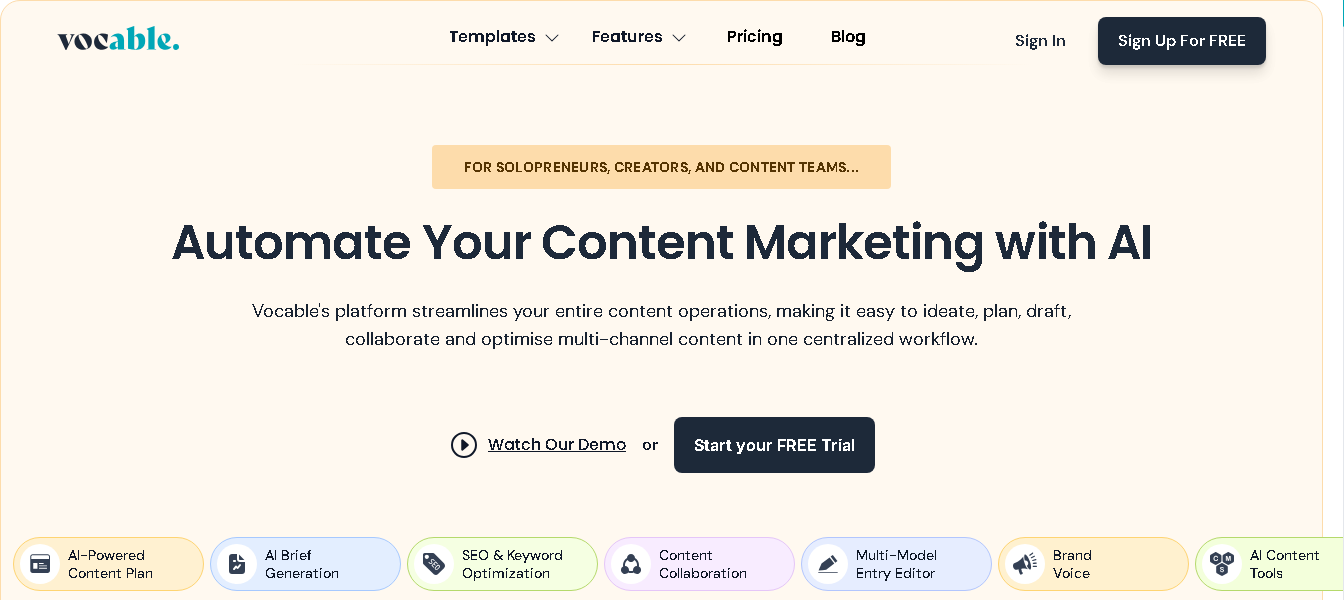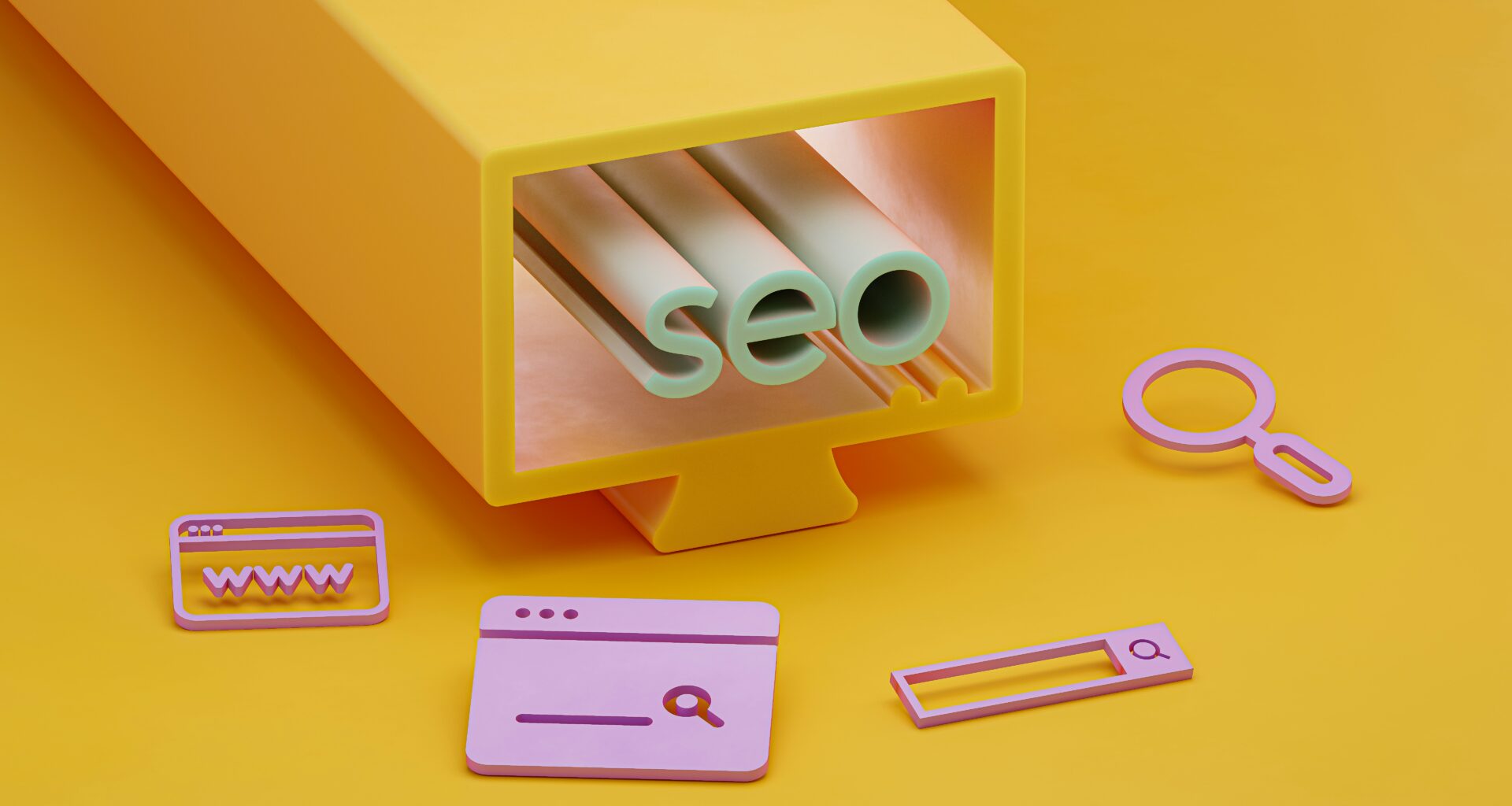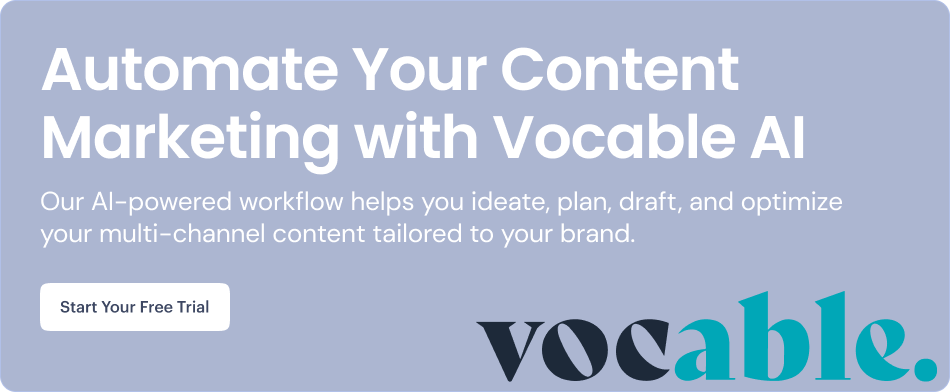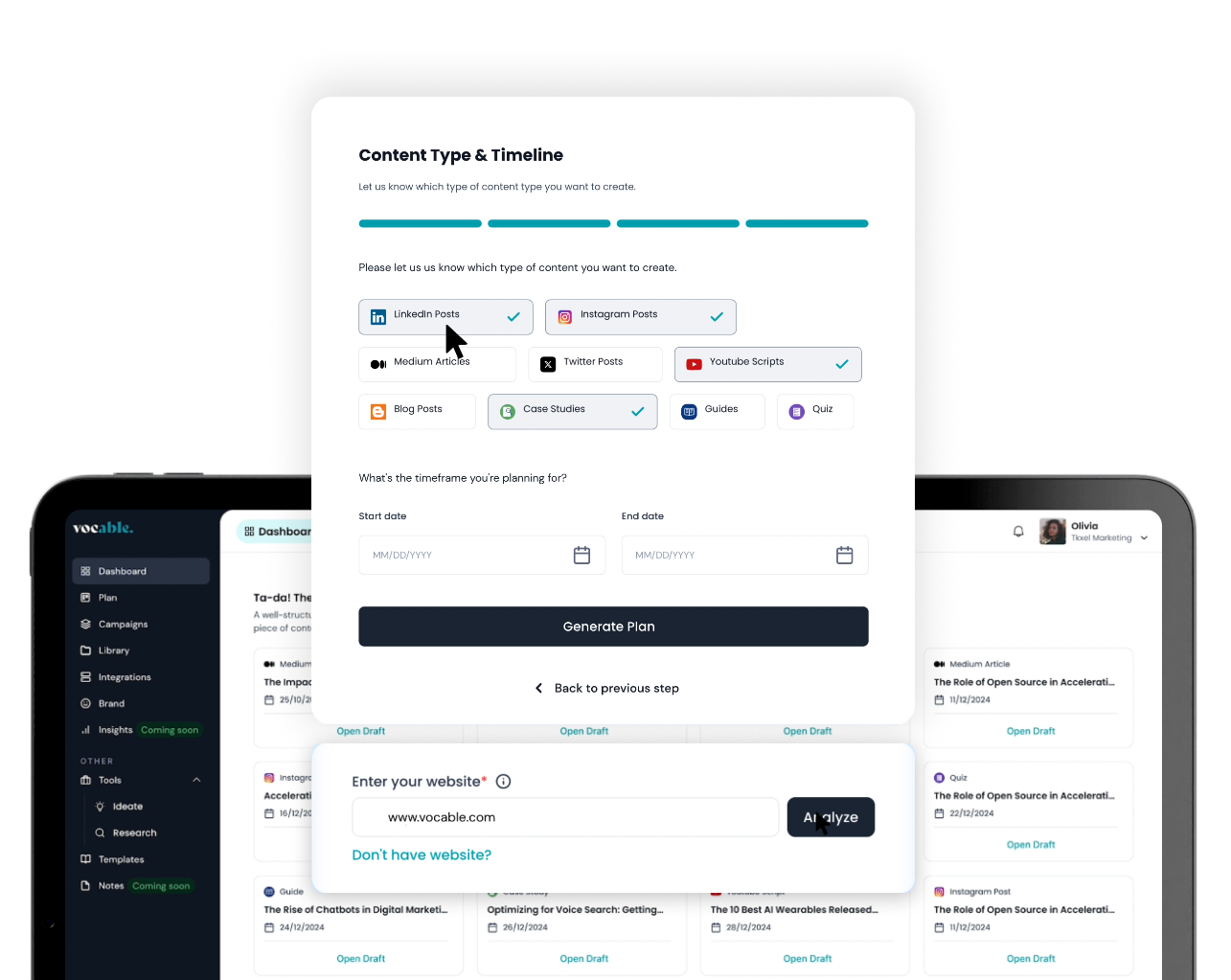Combining Human Creativity and AI-Assisted Content Creation

Iman OubouFebruary 13, 2025 4 min read
Digital content creation is changing fast, and something exciting is happening—humans and AI are teaming up.
This isn’t just about technology getting smarter; it’s about how AI is helping humans create content in new ways. The goal isn’t to replace human creativity but to boost it, making content marketing better than ever.
Let’s take a closer look at how this partnership between people and AI is changing how we work.
The Evolution of Content Creation
Not too long ago, content creation was almost entirely manual. Writers, editors, and designers worked alone, with limited tools. Moving from typewriters to word processors was a big step forward. It made writing faster, but the creative work still depended entirely on human effort.
The Digital Age: New Tools, Same Creative Process
The digital era brought a wave of tools for content creators—content management systems, digital asset platforms, and analytics software. These tools helped speed up production and distribution. But while they made managing content easier, they didn’t change how content was created.
At the same time, the internet’s growing demand for content put pressure on creators to produce more, often sacrificing quality and originality to keep up.
Big Data and Machine Learning: AI Steps In
Things started to change with the rise of big data and machine learning. At first, AI handled simple tasks like analyzing data and automating repetitive work. It didn’t directly create content, but it laid the foundation for what came next.
As natural language processing (NLP) improved, AI began to take a more active role in writing and generating content.
Today: AI as a Creative Partner
Now, we’ve reached an exciting point. AI is no longer just a tool—it’s becoming a creative collaborator. Some people worried that AI would replace human jobs or take away creativity.
But the reality is much more interesting. AI is here to support creativity, not replace it, opening up new possibilities for content creation.
AI's Role in Content Workflows
Let’s discuss in detail how AI is making content workflows easier and faster:
Ideation and Research
AI tools are becoming super helpful at the start of content creation. They can analyze tons of data, like existing content, search trends, and user behavior, to find content gaps and suggest topics that will connect with your audience. This makes it easier for content creators to stay on top of trends and create relevant content.
AI also speeds up research. With natural language processing, it can quickly summarize long articles, highlight key points from papers, and even create literature reviews. What would take hours to research manually can now be done in minutes, giving creators a solid starting point.
Content Generation and Optimization
One of the more debated but powerful ways AI is changing content workflows is through content generation. Advanced AI can write human-like drafts on many topics. While these drafts might not capture the full creativity and nuance of human writing, they’re a great starting point. They save time on first drafts, so writers can focus on improving the content and adding their personal touch.
AI is also great at content optimization. It suggests SEO-friendly headlines, recommends where to place keywords, and helps with keyword density. This makes content not only engaging but also easier to find online.
Personalization and Distribution
The days of one-size-fits-all content are over. Thanks to AI, content can now be personalized based on user preferences and behavior. AI adjusts content in real time, so each person gets a more relevant experience.
It doesn’t stop there—AI also helps with content distribution. It figures out the best channels, timing, and formats to reach more people and boost engagement.
Performance Analysis and Iteration
AI keeps working even after content is published. Machine learning tracks how content performs in real time, giving insights into user engagement, conversion rates, and other important metrics. This feedback helps creators adjust their strategy and improve future content quickly.
Enhancing Human Creativity with AI
AI is powerful, but the real magic happens when it works alongside human creativity. It’s not here to replace creators but to help them work faster and better. When human ideas and AI efficiency come together, great things can happen:
1. Overcoming Creative Blocks
Every content creator knows the struggle of staring at a blank page. AI makes this easier by offering ideas, outlines, or even rough drafts. These starting points spark creativity and help writers break through mental blocks, making it easier to get the words flowing.
2. Expanding Creative Horizons
AI’s ability to process huge amounts of information opens up new possibilities for content creators. It brings fresh ideas, perspectives, and approaches they might not have considered before.
By analyzing data from different sources, AI can highlight trends, cultural insights, and emerging topics that aren’t always obvious.
AI can even connect unrelated fields, inspiring new ideas and encouraging collaboration. It also helps spot content gaps, pushing creators to explore new topics and meet audience needs. When human creativity blends with AI insights, it leads to more diverse, relevant, and interesting content.
3. Enhancing Productivity
AI takes care of routine tasks and simplifies workflows, giving creators more time for the creative work that really matters. This extra time lets them dive deeper into ideas, do better research, and take on bigger projects that used to feel too time-consuming.
4. Data-Driven Creativity
AI gives creators valuable insights into what the audience likes and how content is performing. Instead of limiting creativity, this data helps guide it. Creators can use these insights to make smarter decisions about what content to create and how to present it.
Case Studies: AI-Human Collaboration in Action
To show how AI and human collaboration can change content creation, let’s look at a few real-life examples:
Netflix’s Personalized Content Suggestions
Netflix’s recommendation system is a great example of AI making the content experience more personal. It studies what you watch, your ratings, and even the time of day you’re watching to suggest shows and movies you’ll enjoy.
These insights also help Netflix decide what new content to produce, showing how AI connects what people watch with what gets created.
Google DeepDream & Emily’s Forest Painting
Emily’s artistic journey perfectly illustrates how AI and human creativity can work together. As a traditional painter seeking new inspiration, she used Google’s DeepDream to transform a serene forest image into a stunning abstract piece filled with vibrant colors and intricate patterns.
Rather than simply reproducing the AI output, Emily combined its patterns with her own artistic style. She carefully selected a color palette and painting techniques that reflected the AI-generated design while maintaining her unique touch. The process was collaborative—Emily sought feedback from other artists, which helped her refine her work and make thoughtful artistic decisions.
The final painting is a true blend of human creativity and AI innovation. The AI brought fresh ideas, while Emily’s skill and personal expression gave the piece emotional depth.
The result is a dreamlike, visually striking artwork that highlights the powerful potential of AI as a creative partner rather than a replacement for human imagination.
Alibaba’s AI Copywriter for Product Descriptions
Alibaba built an AI tool that writes product descriptions at super speed—20,000 lines of copy per second! Merchants use it to create descriptions quickly, but human copywriters still step in to refine the content and make sure it fits the brand’s voice.
This shows how AI can handle large content tasks while humans focus on creativity and strategy.
Best Practices for AI-Human Collaboration
AI brings big opportunities to content creation. But to get the most out of it, organizations and creators need to combine the power of AI with human creativity. Here are a few best practices to keep in mind:
1. Define Clear Roles and Responsibilities
To get the most out of AI and human collaboration, it’s important to define who does what. AI and humans have different strengths, and when you combine them, you can build a smart, efficient workflow.
How AI handles the technical stuff:
- Data analysis – AI can process huge amounts of data quickly, helping you spot patterns and trends.
- Pattern recognition – It’s great at identifying connections that might not be obvious.
- Repetitive tasks – AI can automate time-consuming jobs like sorting data or generating reports.
How you can add a human touch:
- Emotional intelligence – Humans understand tone, empathy, and how to connect with an audience on a deeper level.
- Contextual understanding – We can pick up on cultural nuances and real-world context that AI might miss.
- Original thinking – Humans bring fresh ideas and creative problem-solving to projects.
Give the right tasks to the right team member—whether it’s AI or a person. AI handles repetitive tasks, while people focus on creativity and strategy. Finding this balance makes the workflow smoother and more productive.
2. Invest in AI Literacy
To work well with AI, human creators must understand what AI can and can’t do. Knowing its strengths and limitations helps teams use AI tools better and offers feedback that can make those tools even more useful. Regular training and open conversations about AI can also ease concerns and build confidence.
Here are some tips:
- Learn the basics – Start with the fundamentals of how AI works and its key functions. This helps you understand what to expect from it.
- Understand limitations – AI isn’t perfect. It excels at tasks like data processing and pattern detection but can struggle with nuance, creativity, or emotional context.
- Stay updated – AI tools evolve quickly. Keep up with the latest features and improvements so you can use them effectively.
- Hands-on practice – The best way to get comfortable with AI is to use it. Experiment with different tools to see how they fit your workflow.
- Open communication – Encourage ongoing discussions within your team about AI experiences, challenges, and best practices.
3. Maintain Human Oversight
AI can produce amazing content, but human oversight is still essential. AI-generated content needs a human touch to maintain accuracy, consistency, and the right tone.
By putting review processes in place, human editors can ensure the content meets quality standards and stays true to your brand’s voice. Regular review also helps improve the AI’s performance over time.
Why human review matters:
- Check for accuracy – AI can occasionally make factual errors or misinterpret data. Human editors ensure the content is factually correct.
- Maintain the right tone – While AI can mimic a certain style, humans are better at adjusting the tone to match the audience and context.
- Protect your brand voice – Every brand has a unique voice. Human editors ensure the content feels authentic and aligns with the brand’s identity.
- Catch sensitive or nuanced issues – AI might miss cultural references, humor, or sensitive language. Human reviewers can spot and correct these.
- Refine AI performance – Regular feedback from human editors helps improve AI output, making future content more reliable and consistent.
4. Foster a Culture of Innovation
Experimenting with AI tools can open up new opportunities for creativity and innovation. Encouraging your team to explore AI’s possibilities helps them discover fresh ways to work smarter and solve problems.
When both AI capabilities and human creativity are equally valued, you build a culture of learning and growth. This leads to continuous improvement and keeps your team excited about what’s possible.
Here are some tips:
- Celebrate creative ideas – Recognize and reward team members who find smart ways to use AI in their work.
- Offer time for exploration – Give your team time and space to experiment without the pressure of immediate results.
- Share success stories – Highlight examples of how AI helped improve outcomes to inspire others.
- Provide ongoing support – Offer training and resources so your team can keep learning and exploring AI tools.
5. Prioritize Ethical Considerations
As AI plays a bigger role in content creation, it’s important to think about the ethical side. Using AI without clear guidelines can lead to problems like bias, misinformation, and loss of trust.
To prevent this, establish clear policies that address ethical concerns. Focus on areas like fairness, transparency, and proper attribution to maintain credibility and trust with your audience.
Key areas for ethical AI use:
- Avoid bias – AI systems can reflect biases present in the data they are trained on. Regularly review content for fairness and inclusivity to reduce this risk.
- Maintain transparency – Be open about when and how AI is used. If your content is AI-generated, let your audience know. Transparency builds trust and keeps your communication honest.
- Give proper attribution – Clearly label AI-generated content when appropriate. If human contributors and AI worked together, explain how each contributed.
- Protect privacy – Ensure your AI tools handle user data responsibly. Don’t compromise personal data for the sake of efficiency.
- Focus on accuracy – AI-generated content can sometimes be misleading or incorrect. Always have human oversight to fact-check and confirm accuracy before publishing.
6. Iterate and Refine
The field of AI is moving fast. What works today might not be the best approach tomorrow. That’s why it’s essential to regularly evaluate how well your AI-human collaboration strategies are working.
- Schedule regular check-ins – Set up quarterly or monthly reviews to evaluate how AI tools are performing and how well they fit into your workflows.
- Collect team feedback – Ask your team for input on how AI tools help (or hinder) their work. They’re the ones using these tools every day and can offer valuable insights.
- Gather audience feedback – Pay attention to comments, surveys, and engagement metrics to see how your audience responds to AI-generated content.
- Experiment and adjust – Don’t be afraid to tweak your strategy and test new approaches based on what you learn.
- Stay informed – Keep an eye on AI trends and new tools that could improve your current setup.
Use Vocable to Speed Up Content Creation Without Losing Your Style

Vocable blends the best of AI technology with human creativity to help you create high-quality content faster. It’s not about replacing writers—it’s about giving you a smart assistant that makes your content process easier and more efficient.
With Vocable, you can generate fresh ideas, speed up drafting, and polish your content, all while keeping your unique voice and creativity front and center. AI takes care of the repetitive tasks so you can focus on what you do best—creating engaging, original content.
AI as Your Writing Assistant, Not a Replacement
Vocable helps you get started quickly by generating drafts, but you always have the final say. Edit, refine, and add your own personal touch to make the content truly yours.
Faster Drafting, More Time for Creativity
Let AI handle the first draft while you focus on fine-tuning the message and adding the creative spark that only a human can bring.
Smart Content Suggestions
Vocable’s AI gives you insights on keywords, trending topics, and structure, helping you create more targeted and engaging content without losing your creative flow.
Collaborate with AI and Your Team
Whether you’re working alone or with a team, Vocable’s real-time editor and collaboration tools help you seamlessly combine AI support with human creativity.
Use AI to work smarter, not harder. Let Vocable handle the busy work while you bring the creative magic. Sign up now!
FAQs About AI-Assisted Content Creation
What is AI-assisted content?
AI-assisted content refers to content created with the help of artificial intelligence. It can generate text, images, and videos using advanced technologies like natural language processing and machine learning. AI content generation tools help speed up the content creation process for things like blog posts, social media management, and more. These tools are designed to make content creation faster and easier without needing to write everything from scratch.
Can I sell content created by AI?
Yes, you can sell AI-generated content as long as it meets legal and ethical standards. Many businesses use AI writing tools to create content for blogs, marketing materials, and social media posts. You can even create AI-generated videos to promote your brand.
However, it’s important to review and edit the content to make sure it aligns with your brand’s tone and is relevant to your target audience. Even though AI makes things faster, adding a human touch is still essential for better audience engagement and a consistent brand voice.
How does AI affect human creativity?
Generative AI is a helpful tool that can spark ideas and reduce repetitive tasks in the content creation process. It allows creators to focus more on strategy and storytelling. For example, AI tools can suggest content ideas, create AI-generated images, or help write captions for social media content creation. While AI is great for automating parts of the process, human creativity is still key for connecting with the audience on a personal level and creating content that feels authentic.
How to humanize AI content?
To humanize AI-generated content, you need to add personality and emotion. Start by reviewing and editing the content so it sounds natural and conversational. Think about your target audience and make sure the tone fits your social media content strategy. Personal stories, relatable language, and addressing your audience’s needs help make the content feel more genuine. Mixing AI-generated ideas with real human input ensures a balance between automation and creativity, improving audience engagement.
Get Started with Vocable
Master every aspect of Vocable, from automated content planning to publishing in these step-by-step tutorials and product guides.
Get Started Now





